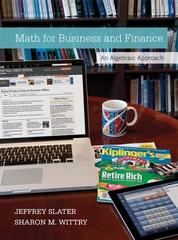Question
50. In microeconomics, the distinguishing characteristic of the supply side in the long run is that a. Firms are not allowed to enter or exit
50. In microeconomics, the distinguishing characteristic of the supply side in the long run is that
a. Firms are not allowed to enter or exit the industry
b. Only demand factors determine price and output
c. Only supply factors determine price and output
d. All inputs are variable
51. In the long run, a firm may experience increasing returns due to
a. Law of diminishing returns c. Comparative advantage
b. Opportunity costs d. Economies of scale
52. Because of the existence of economies of scale, business may find that
a. As more labor is added to a factory, increases in output will diminish in the short run
b. Each additional unit of labor is less efficient than the previous unit
c. Increasing the size of a factory will result in lower average costs
d. Increasing the size of a factory will result in lower total costs
53. The law of diminishing marginal utility states that
a. Marginal utility will decline as a consumer acquires additional units of a specific product
b. Total utility will decline as a consumer acquires additional units of a specific product
c. Declining utilities causes the demand curve to slope upward
d. Consumers' wants will diminish with the passage of time
MARKET STRUCTURES
54. The measurement of the benefit lost by using resources for a given purpose is
a. Economic efficiency c. Comparative advantage
b. Opportunity cost d. Absolute advantage
55. If an individual uses P 10,000 from savings account, which was paying 5% interest annually, to invest in saloon, then
opportunity cost of this investment would annually be:
a. P 500 c. P 10,500
b. P 10,000 d. The dividend paid by the coffee shop
56. The definition of economic cost is:
a. All peso costs employers pay for all inputs purchased
b. The opportunity cost of all inputs minus the peso cost of these inputs
c. The difference between all implicit and explicit costs of the business firm
d. The sum of all explicit and implicit costs (e.g., opportunity costs) of the business firm
57. Which type of economic market structure is composed of a large number of sellers, each producing an identical product,
and with no significant barriers to entry and exit?
a. Monopoly c. Perfect competition
b. Oligopoly d. Monopolistic competition
58. A market with many independent firms, low barriers to entry, and product differentiation is best classified as
a. A monopoly c. Monopolistic competition
b. A natural monopoly d. An oligopoly
59. Economic markets that are characterized by monopolistic competition have all of the following characteristics, EXCEPT
a. One seller of the product c. Advertising
b. Economies or diseconomies of scale d. Heterogeneous products
60. Which type of economic market structure is characterized by a few large sellers of a product or service, engaging primarily
in nonprice competition?
a. Monopoly c. Perfect competition
b. Oligopoly d. Monopolistic competition
61. A natural monopoly exists because
a. The firms holds patents
b. The firm owns naturals resources
c. The government is the only supplier
d. Economic and technical conditions permit only one efficient supplier
62. Which of these organizations would MOST LIKELY engage in public relations type advertising?
a. An airline c. A toy manufacturer
b. A hotel chain d. An electric utility company
63. Which of the following is NOT a key assumption of perfect competition?
a. Firms sell a homogeneous product
b. Customers are indifferent about which firm they buy from
c. The level of a firm's output is small relative to the industry's total output
d. Each firm can price its product above the industry
64. Which of the following is NOT a characteristic of a purely competitive market?
a. Differentiated products
b. A very large number of producing firms
c. No barriers to market entry for new firms
d. Lack of control over product price by individual firms
65. Which of the following is NOT a likely strategy for a firm in a purely competitive market?
a. Lean manufacturing c. Supply chain management
b. Process reengineering d. Development of a brand name
66. What is the distinguishing characteristic of oligopolistic market?
a. A single seller of a homogeneous product with no close substitutes
b. A single seller of a heterogeneous product with no close substitutes
c. Lack of entry and exit barriers in the industry
d. Mutual interdependence of firm pricing and output decisions
ASAP!!!
Step by Step Solution
There are 3 Steps involved in it
Step: 1

Get Instant Access to Expert-Tailored Solutions
See step-by-step solutions with expert insights and AI powered tools for academic success
Step: 2

Step: 3

Ace Your Homework with AI
Get the answers you need in no time with our AI-driven, step-by-step assistance
Get Started


